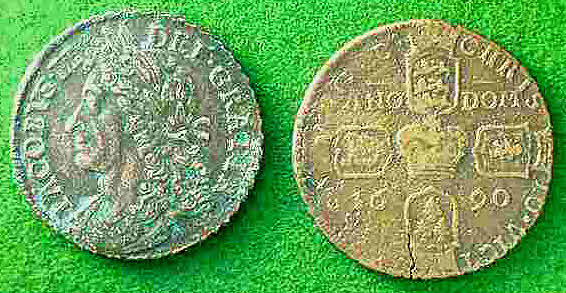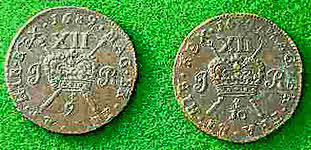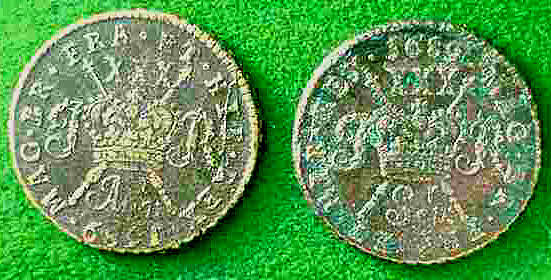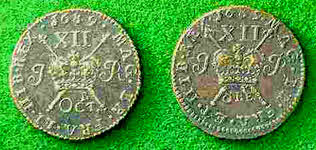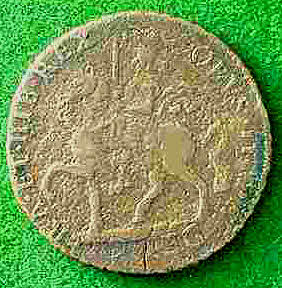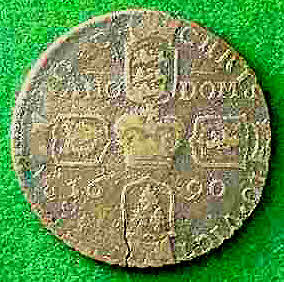Gun money was an issue of coins made by the forces of James II during the Williamite War in Ireland between 1689 and 1691. Minted in base metal, these were designed to be redeemed for silver coins following a victory by James II and consequently bore the date in months to allow a gradual replacement. As James lost the war, that replacement never took place, although the coins were allowed to circulate at much reduced values before the copper coinage was resumed.They were mostly withdrawn from circulation in the early 18th century.
The name "Gun money" stems from the idea that they were minted from melted down guns. However, many other brass objects, such as church bells, were also used.
There were two issues. The first "large" issue consisted of sixpences, shillings and half crowns (2½ shillings). The second, "small" issue consisted of shillings, halfcrowns and crowns (5 shillings). Some of the second issue were overstruck on large issue pieces, with shillings struck over sixpences, half crowns on shillings and crowns on half crowns. The most notable feature of the coins is the date, because the month of striking was also included. This was so that after the war (in the event of James' victory), soldiers would be able to claim interest on their wages, which had been withheld from proper payment for so long.
Specimen strikings were produced in Silver and Gold for most months, and these tend to be extremely rare.

A gun money crown, featuring an equestrian portrait of James II. Unlike the other coins in this series, the crown did not bear the month of issue.
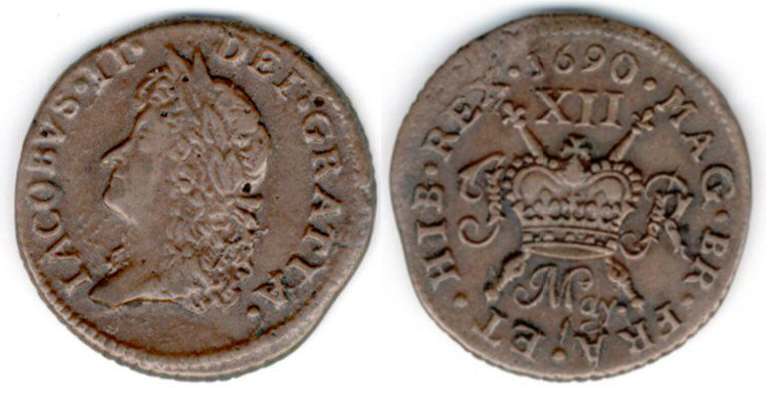
12 shilling, gunmoney, James II, Ireland, May 1690.
Coins issued in Ireland by James II from 1689-90, allegedly made of old brass cannons, and used to finance the "Pretender" who now continued his fight against the Glorious Revoultion from Ireland. A second generation of gun-money coins was issued in smaller shillings and half-crowns after April 1690 due to the metal shortage now affecting the minting. Both lines of production overlapped, the sixpence never appeared in the reduced size.
Gun money was still produced in Limerick after James had escaped to France following the Battle of the Boyne in July 1690, and after the Dublin mint had been taken by William's troops.
The "Gun Money" of James II
The Late Stanley Draper
The title means exactly what it says! These coins were struck in Ireland and used to pay the common soldiers of James II's army, who were helping him to regain the English throne from William and Mary. Most historians believe that the foreign officers - mostly French, Spanish and Portuguese - refused to be paid in anything other than gold or silver.
"Gun Money" consisted mostly of old cannon or church bells, and they looked brassy or coppery according to the "mix". The main mint was at Dublin, but in 1690 - when Limerick was under siege until 1691 - a second mint was set up.
In 1689, at the start of proceedings, three denominations were minted: halfcrowns, shillings, and sixpences. They were all dated 1689 and bore the month of the year, abbreviated in some cases to three letters only on the reverse. On the obverse they bore a portrait of James II. Sixpences were the first to be struck in June 1689 - all these coins are unique in having the month and date on them, as they are the only British coins to have this distinction.
As 1689 progressed, however, James' first issue of coins was running out owing to a lack of materials at the Dublin mint. Not only that, but James was also running out of funds to pay his army, so he hit on a cunning scheme - by issuing a Royal Proclamation dated June 1690, he had all the old original halfcrowns struck before the preceding May handed in and restamped or coined as crown (five shilling) pieces of the same size. Remember, New Year's Day was 25th March in those days. A second minting of shillings and sixpences was also made, both on smaller size flans in order to conserve stocks. As mentioned previously, the Limerick mint helped to produce these coins and in addition they struck a few crowns in gold, silver, pewter, and white metal. All coins were dated 1690, with the latter being very rare.
The new crown pieces showed the king on horseback on the obverse, in armour, with an upright drawn sword in his left hand. On the reverse were four crowned shields, cross wise, in the centre a crown with "CHRISTO, VICTORE, TRIVMPHO" and the date 1690 - but no month!
James was responsible for one of the first devaluations of the coinage, and certainly for the biggest since the reign of Henry VIII, whose speciality was debasing the gold and silver in his coffers!
